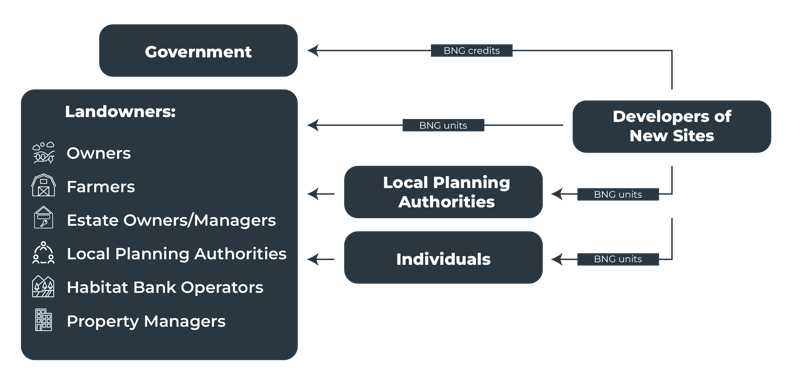Biodiversity units are based on the size, condition and distinctiveness of the habitats. Statutory credits are administered by the government and have higher prices than off-site units.
The UK government has introduced new biodiversity net gain regulations (BNG), which means that most developments in England will need to achieve a minimum 10% increase in the biodiversity value of habitats on and around the development site. To measure this, developers use a tool called the biodiversity metric 4.0, which calculates the number of biodiversity units before and after the development. Biodiversity units are based on the size, condition and distinctiveness of the habitats.
Where developers cannot incorporate 10% BNG on-site, off-site biodiversity units can be purchased from land managers who create or enhance habitats on their land. Statutory credits are administered by the government and have higher prices than off-site units. They also must only be used as the very last resort and have this approved by an ecologist before they can be purchased.
How do developers achieve Net Gain?
Developers have three options to deliver BNG: on-site, off-site or through statutory credits.
- On-site BNG means creating or enhancing habitats within the development site.
- Off-site BNG means buying biodiversity units from another landowner who has created or enhanced habitats in the local area.
- Statutory credits are the last resort option, when developers cannot use on-site or off-site BNG. Statutory credits are sold by the government and are used to fund habitat creation projects across England. Statutory credits are more expensive than off-site biodiversity units, to encourage the development of the private market.

What is the difference between BNG Units and BNG Credits?
Land managers have the option to sell BNG units when they assess the biodiversity value of their land using a metric that considers factors such as habitat type, condition, size and location. This metric also considers the connectivity between habitats and their contribution to national nature recovery goals.
The term "land managers" refers to individuals or organisations involved in owning, managing or providing advice on land. This includes landowners, farmers, estate owners, local authorities, habitat bank operators, facility managers, property or estate managers as land agents or advisors. Developers who need to offset the biodiversity impacts of their projects can purchase BNG units from these land managers.
To sell BNG units successfully land managers should follow these steps:

- Determine the habitat needs of their area by referencing the relevant Local Nature Recovery Strategy (LNRS) for their land. LNRSs outline priority areas for nature conservation. Provide guidance on restoration and enhancement efforts.
- Explore opportunities to combine BNG with environmental payment schemes, like credits or agri environment schemes. Nutrient credits offer a way to reduce water pollution by creating or restoring wetlands of absorbing nutrients from agricultural runoff or sewage. Agri-environment programs are incentives provided to farmers as a reward, for adopting land management practices that contribute positively to the environment, wildlife preservation, landscape conservation and climate mitigation.
- To determine the number of BNG units, on their site they should consult with an ecologist and utilise the biodiversity metric. They have two options for habitat management; either create or enhance habitat before selling it (known as habitat banking) or do so after finding a buyer (known as contract growing). If any habitat improvement was undertaken on their land prior to January 30, 2020, they must recalculate their BNG units.
- In order to secure the land, they need to enter into an agreement committing them to managing the habitat for a minimum of 30 years. This agreement could take the form of a planning obligation (section 106) with the planning authority (LPA) a conservation covenant with a body (such as a charity or public organisation) or a combination of both. Additionally, they are required to establish and agree upon a habitat management and monitoring plan (HMMP) that outlines how they will maintain and enhance the quality of the habitat over time in collaboration with their LPA or responsible body.
Land managers have options for selling BNG units:
- Directly sell them to developers either independently or through intermediaries like brokers or trading platforms.
- Collaborate with their LPA to allocate BNG units from their land to developers in exchange for compensation. This arrangement assists LPAs in fulfilling their obligation to secure BNG for developments within their jurisdiction.
- A habitat bank operator allows individuals to purchase BNG units from their land and then sell them to developers or LPAs. These habitat banks consist of areas of land that offer BNG units, for development projects. They are regulated by Natural England and need to meet certain standards of quality and security.
BNG statutory credits differ from these units because they are issued by the UK government not by land managers or local planning authorities. They are more expensive and should only be used as a last resort after consultation with a ecologist.
When do developers need to buy BNG credits?
BNG statutory credits are a type of biodiversity offset that can be purchased by companies who need to achieve the 10% BNG but have declared upon consultation with an ecologist that 10% BNG cannot be achieved on-site and there are no options off-site BNG either on a different site owned by the developer or purchased from a land manager. BNG stands for Biodiversity Net Gain, which means that the credits are generated by projects that enhance the natural environment and its wildlife.
WANT TO KNOW MORE ON UNITS AND CREDITS?
Get in touch with our team of scientific biodiversity experts for a free consultation today.


.jpeg?width=300&name=Biodiversity%20Net%20Gain%20Units%20and%20Credits%20(1).jpeg)